‘Stand behind me and you’ll be safe’ he said. Armed with only a small stick, our Komodo National Park guide was trying to be reassuring as we walked between lounging killer Komodo Dragons.
The archipelago of Indonesia has 17,500 islands making it a great place for a cruise. Komodo Island is one of those islands, famous for its population of Komodo Dragons. We took a 3-day 2-night ‘cruise’ from the island of Flores to Komodo to see these killers in person.
Flores is a large island in the Flores Sea. With a population of over 2 million it still has a local charm. The coastal city of Labuan Bajo is where we began our journey. It has a beautiful setting on the edge of turquoise waters with views of the many small, green islands in the bay. Its small harbour is filled with local fishing boats and tourist boats. Calling our trip a cruise is a little generous as our boat was small and tired. The boat had one small bedroom, the crew slept on the deck, and there was no AC. But we had a personalized tour of the Flores Sea, our own guide, captain and an excellent chef who prepared amazing, authentic Indonesian food.
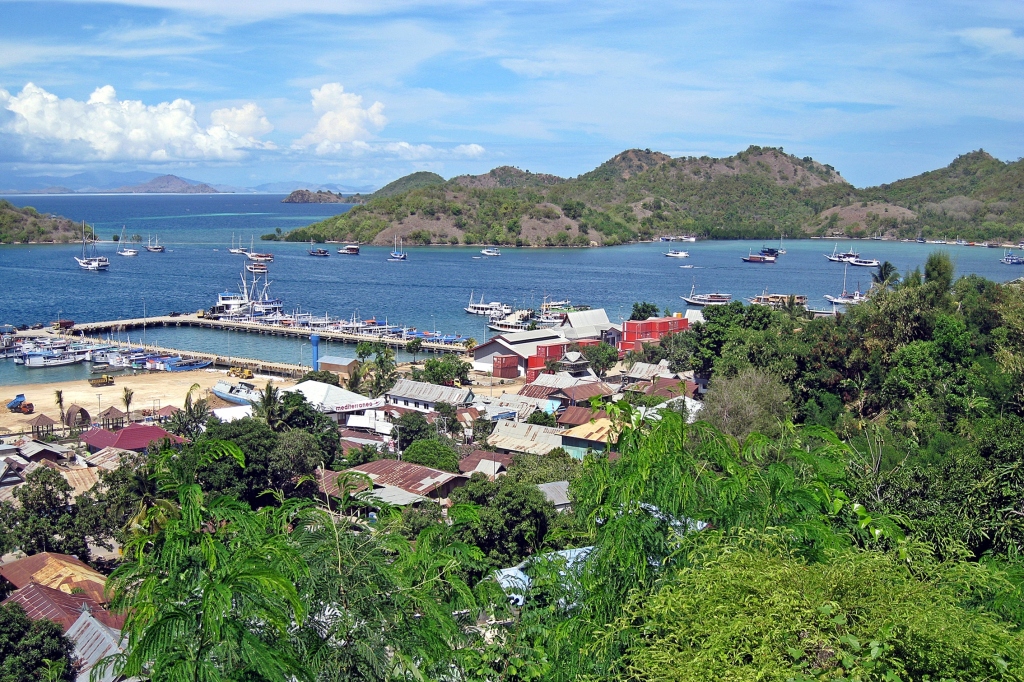
Labuan Boja Harbour, Flores 
Labuan Boja Harbour, Flores 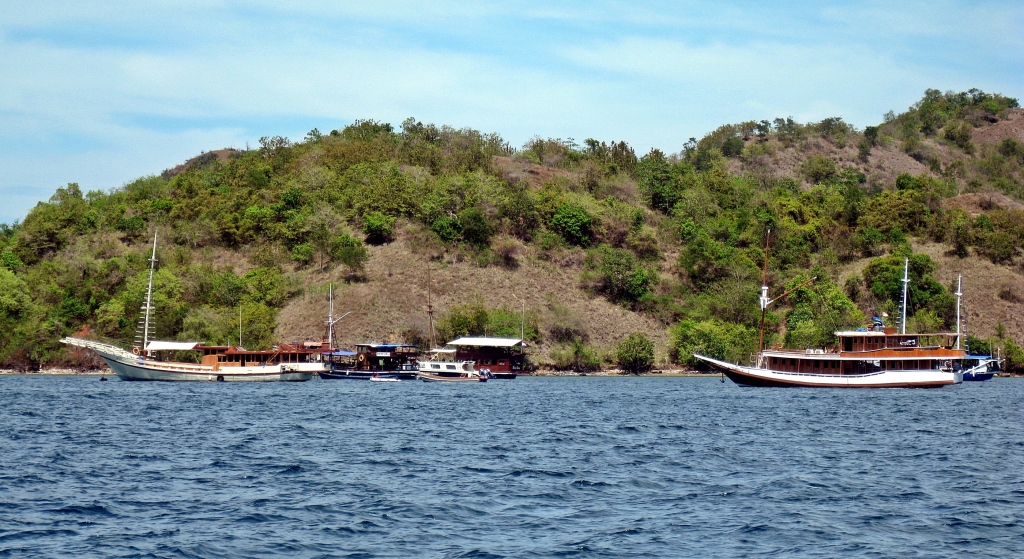
Labuan Boja Harbour, Flores 
Our rustic cruise boat, Flores Sea 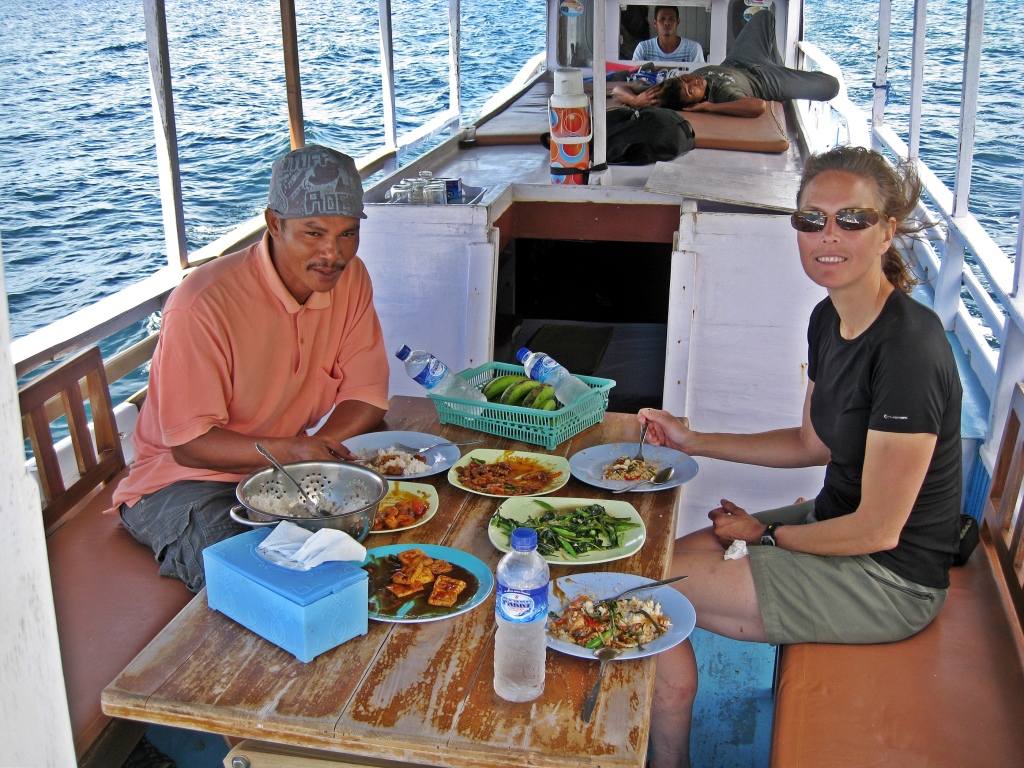
Delicious lunch with our guide on our cruise
During the days we passed many islands and islets; some uninhabited, others housing luxury resorts and a few were populated with small towns. The islands have gorgeous hilly landscapes with either small sandy beaches or aggressive rocky shores. We stopped at a few to snorkel, lie on the beach and hike to the top of the small hills. It’s not a busy area, but we did see a few local fishing boats, some drying fish on the hull. There were a few large sail boats and other tourist boats, but mostly, we had the sea to ourselves. It’s the perfect setting for idle days in the tropics.

Island in the Flores Sea 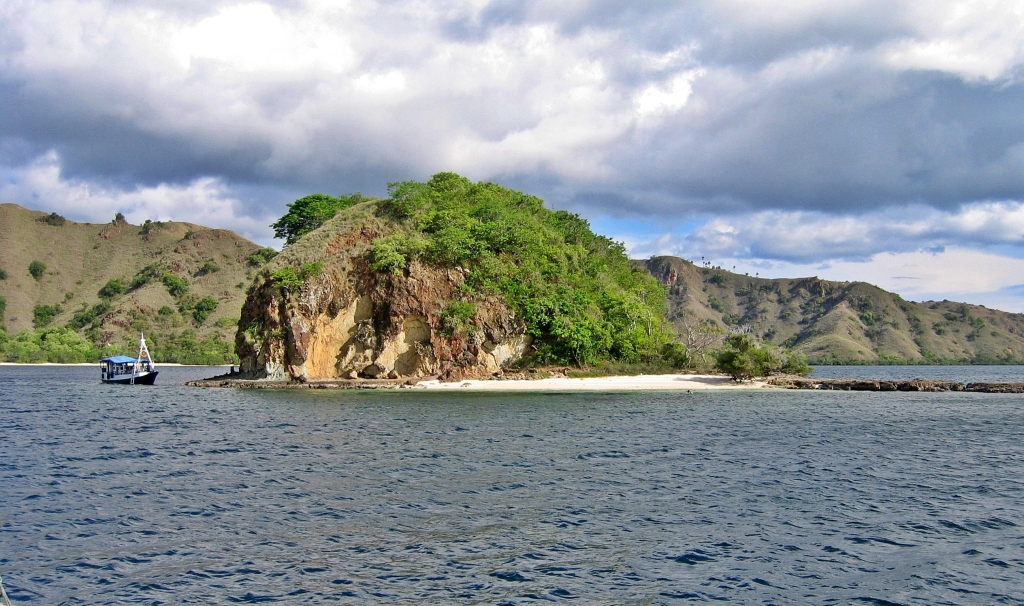
Island in the Flores Sea 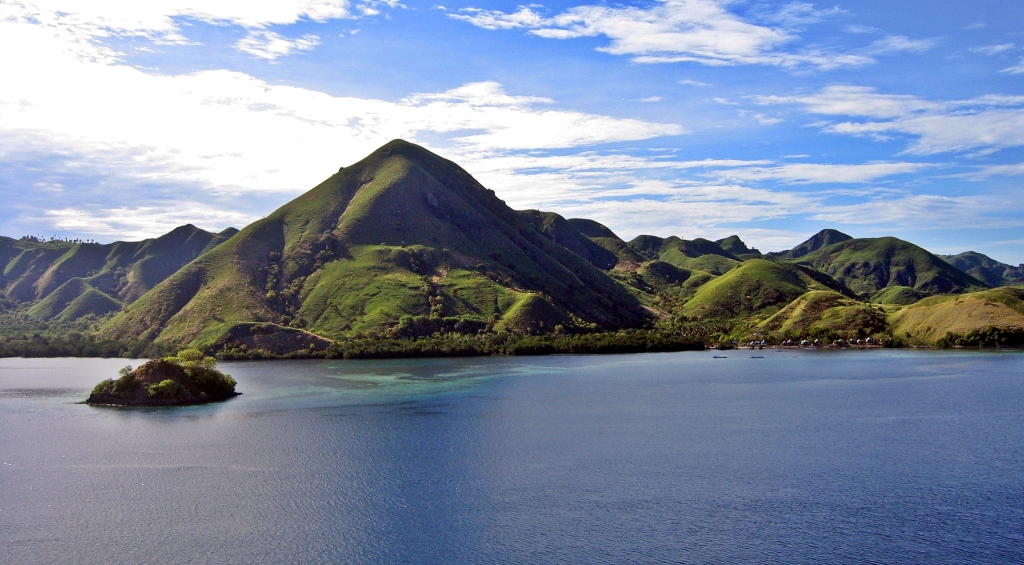
Beautiful vista on the Flores Sea 
Island in the Flores Sea 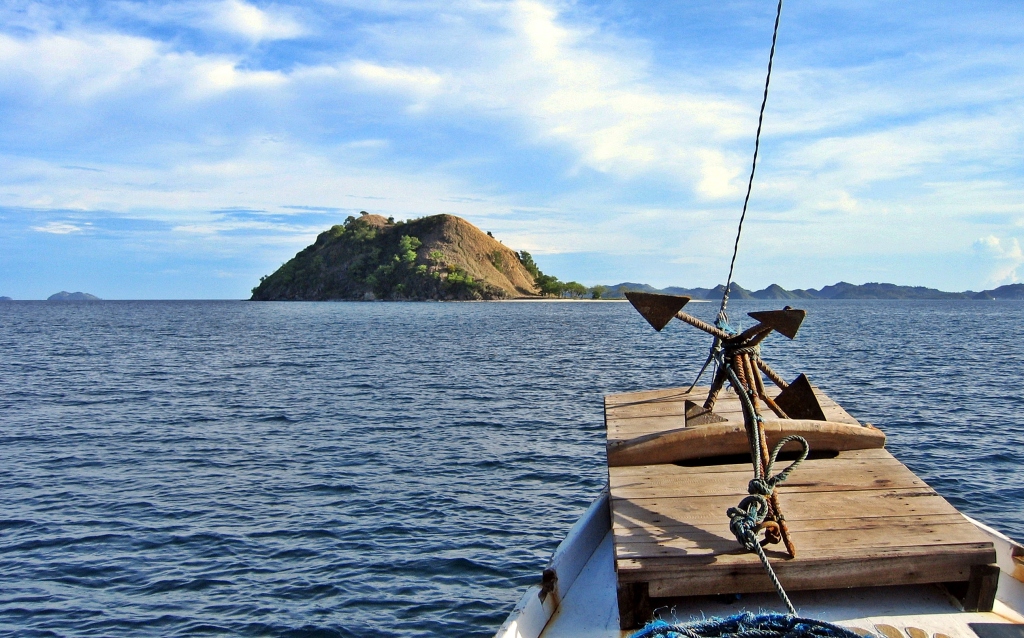
Cruise on the Flores Sea 
Islet in the Flores Sea 
Island in the Flores Sea 
View from an island hilltop, Flores Sea 
Island in the Flores Sea 
Island in the Flores Sea 
View from our cruise on the Flores Sea 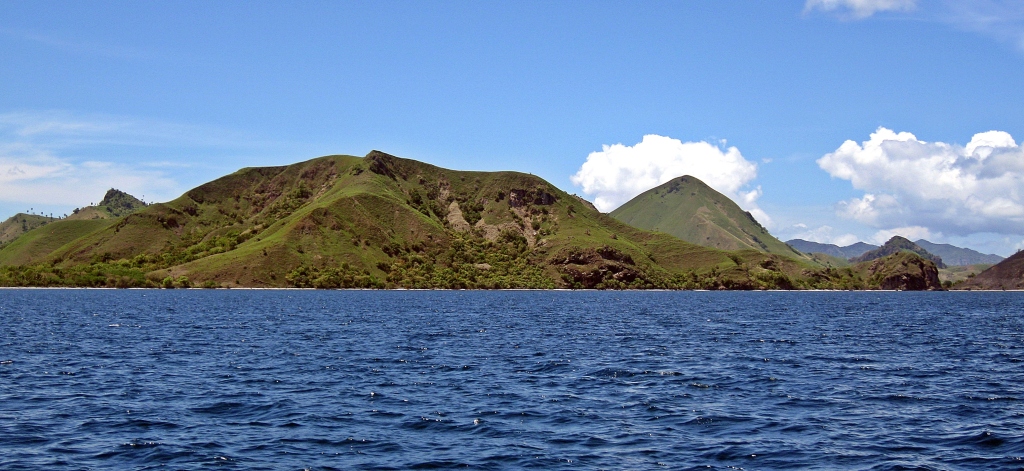
Island in the Flores Sea 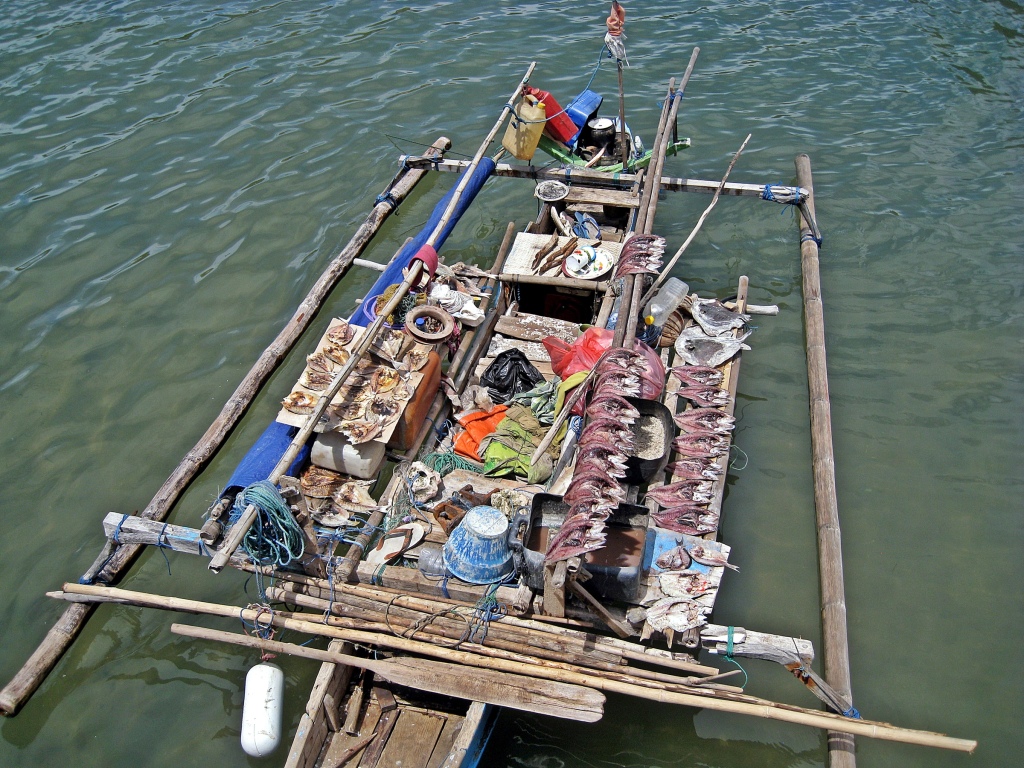
Fishing boat with drying fish, Flores Sea 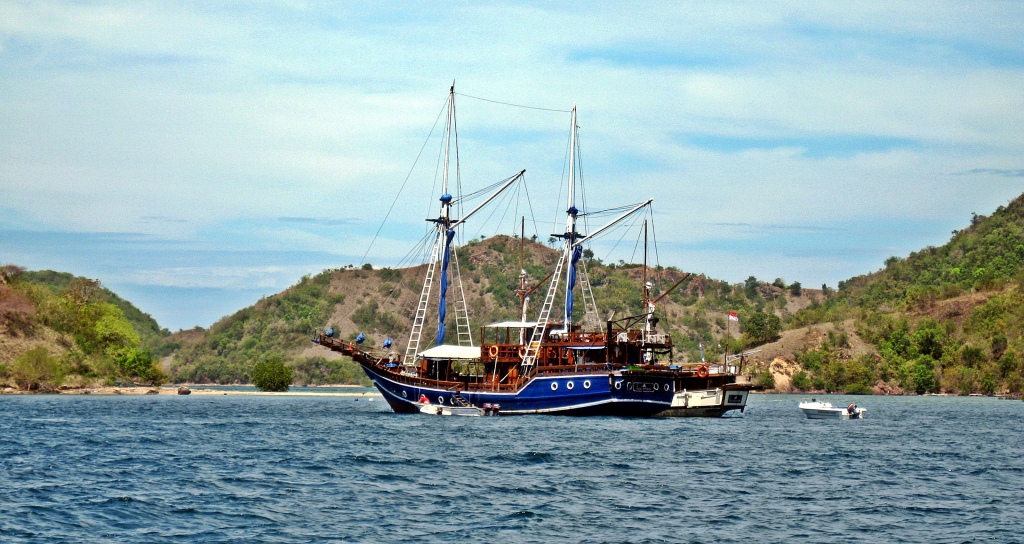
Sailboat, Labuan Harbour
Komodo Island is one of three islands that make up Komodo National Park. To enter the park you are required to hire a National Park Ranger as a guide. The thought of walking around the park with komodos roaming free is a little unnerving, but knowing we had a guide was reassuring. That was until we saw what he would use as protection; a stick. Guides are armed with a 3 foot long stick that has a 2-pronged fork at one end. It’s hard to imagine that a small stick is enough to stop a raging, deadly dragon. Thankfully, we didn’t have an opportunity to test their effectiveness.
Komodos are the largest lizard in the world at up to 3 m in length and weigh over 100 kg. The dragons slowly lumber along, looking from side to side, constantly sticking out their dragon-looking forked tongue. The use their tongues to smell their prey.
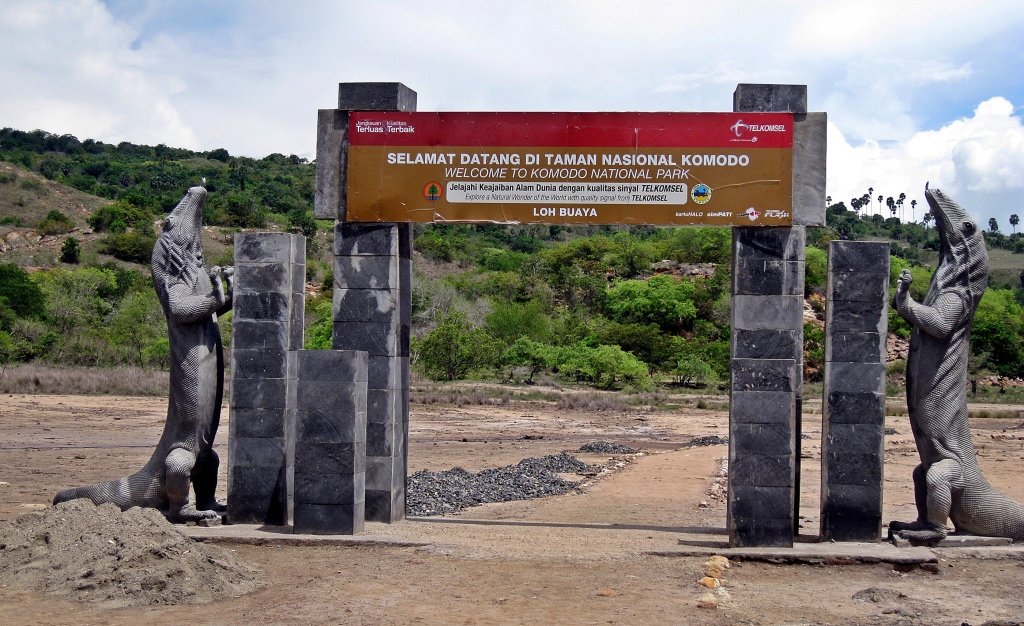
Komodo National Park 
Komodo Dragon, Komodo National Park 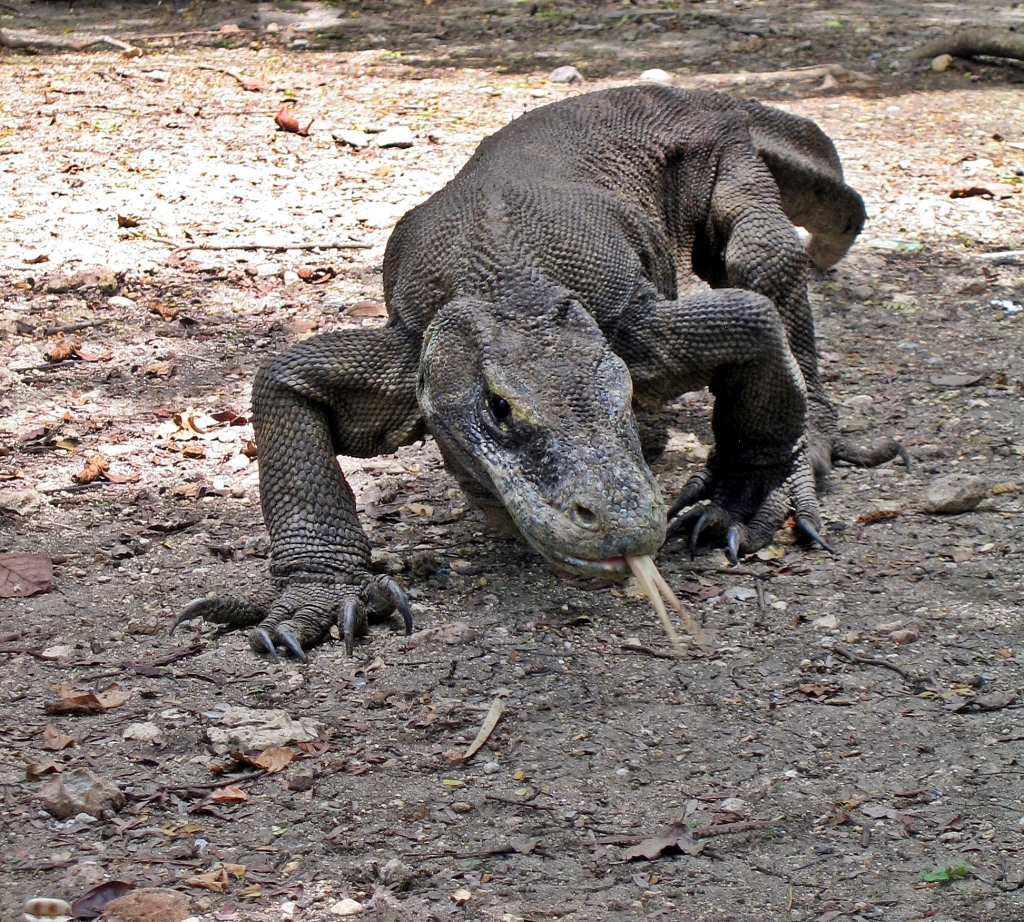
Komodo Dragon with a forked tongue, Komodo National Park 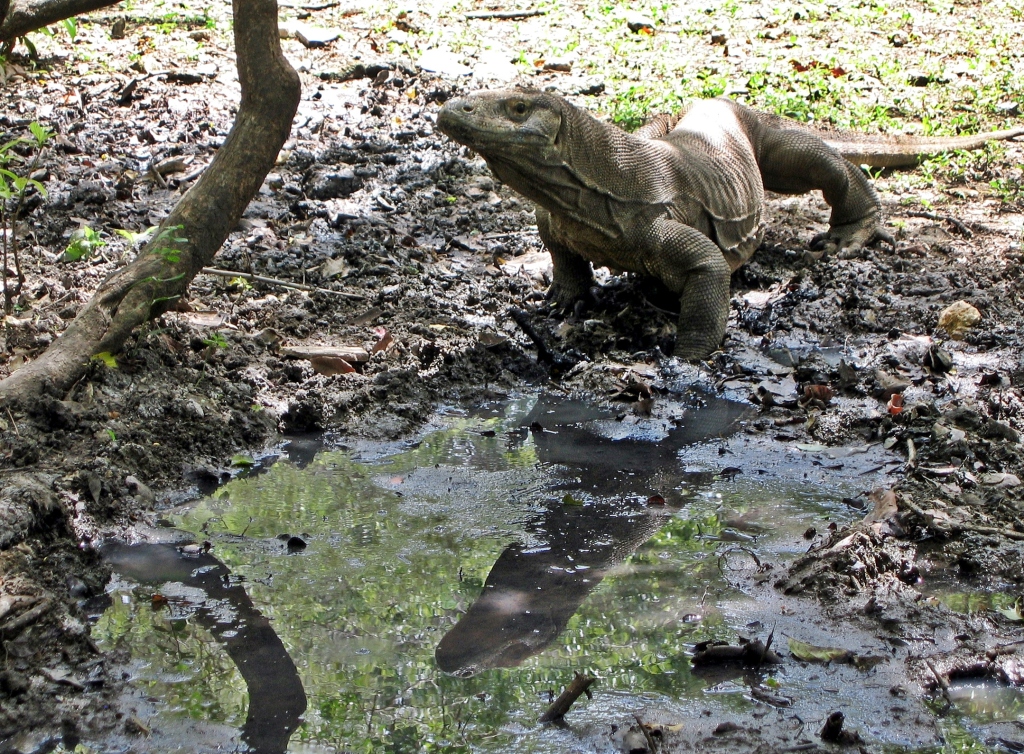
Komodo Dragon, Komodo National Park 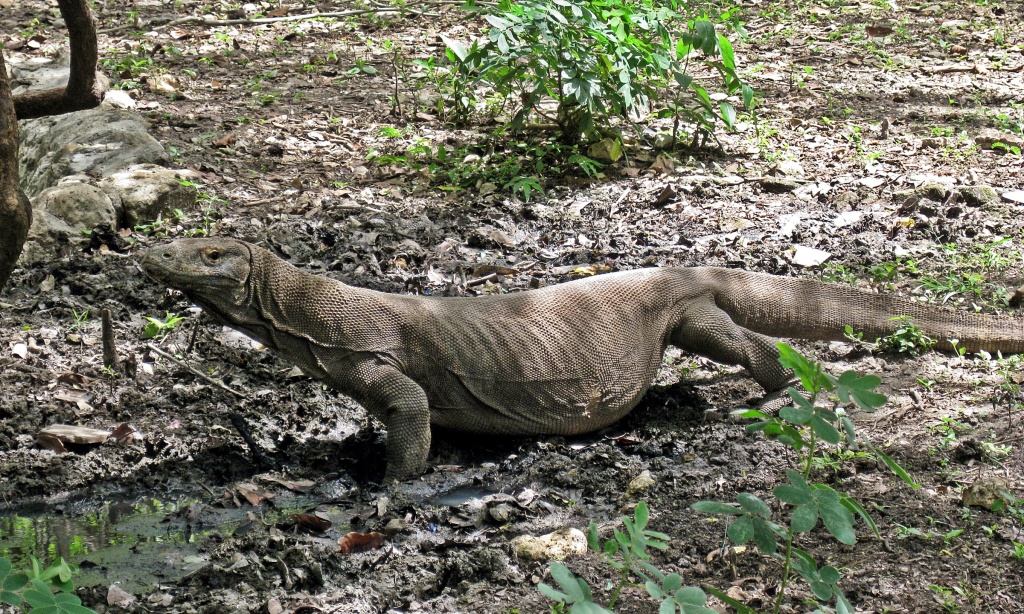
Komodo Dragon, Komodo National Park
Dragons are actually in the monitor lizard family and are known for taking down wild pigs, deer and even water buffalo. They’re very large, but compared to a buffalo, dragons are still quite small. So how do they kill such large beasts? Dragons can run very fast, up to 20 km/hr, but only in short bursts. Once they catch their prey, they bite it, injecting toxic proteins that are secreted from two glands in the lower jaw. The proteins are anticoagulants so the bitten animal bleeds to death. In addition the proteins cause muscle paralysis and hypothermia, leading to shock and loss of consciousness. If their prey doesn’t die from the bite, they slowly die over the next few hours. Komodos eat by tearing large chunks of meat and swallowing whole. They may even eat an entire goat or pig in one meal. Because of their slow metabolism, large dragons can survive on as few as 12 meals a year. After they’ve eaten they laze around while their meal digests. We saw many lounging near the Park Ranger’s cabins. This is why our guide said we were safe to be so close to these beasts. Somehow the guide knew that these ones had already eaten this month.

Dragon leftovers, Komodo National Park 
Komodo Dragons, Komodo National Park 
Komodo Dragon, Komodo National Park 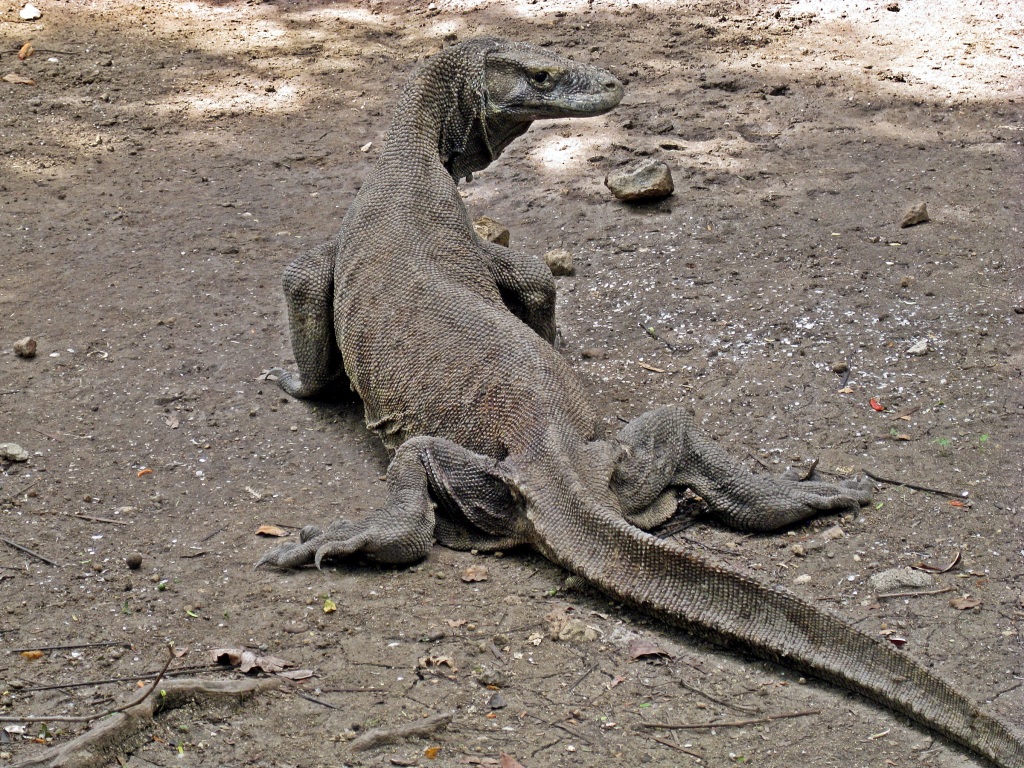
Komodo Dragon, Komodo National Park 
Komodo Dragon, Komodo National Park
After seeing many dragons, we went for a small hike on Komodo Island. It was very hot and dry, but the views we had from the top of a small hill were incredible. The beautiful surrounding, hilly islands and the blue Flores Sea made the hot hike worth while.

View from Komodo Island 
View from Komodo Island 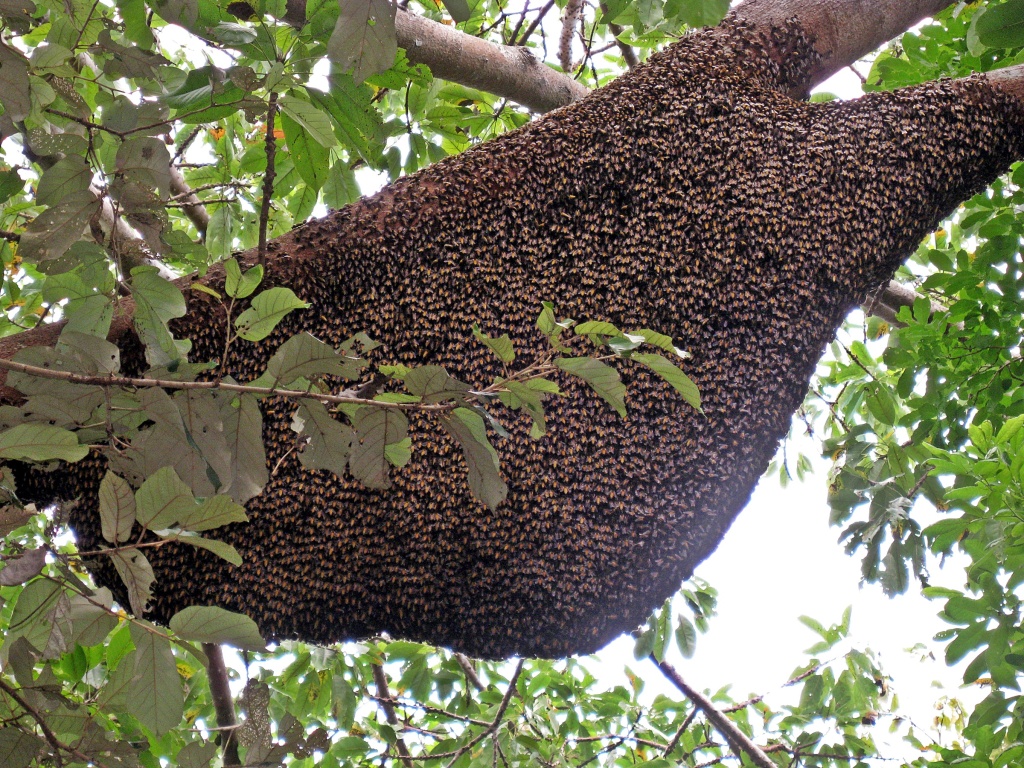
Bees, Komodo National Park
On the last night of our cruise, we moored near a mangrove forest. At sundown, we watched as millions of fruit bats emerge from behind the mangroves, flying high in the sky. It was a spectacular display, but unfortunately we were so excited by the show that we didn’t take any pictures.
Our final day ended up being a little stressful. Our poor old boat had a few problems on the entire cruise. Every time we stopped, one of the staff had to jump in the water to re-connect the rudder. On our last day, as we were heading back to Labuan Bajo harbour to catch a flight, the problem intensified. The rudder was completely broken so the boat could only turn left. The staff worked and worked, trying to repair the broken rudder, but each time they thought it was fixed, the boat would only go around in circles. As time passed and our flight was getting closer, we started to get anxious. The guide finally called a water taxi to pick us up, but since we were still far away, it would take a couple of hours to reach us and return to shore. The solution was for a local fishing boat to give us a ride and meet the water taxi half way. The fishing boat was very basic and the funniest part was their steering. The were two ropes, one on the right and one on the left side of the boat, connected to a home made rudder. They pulled one rope or the other to steer the boat. It was very basic, but effective and this simple rustic, fishing boat got us to the water taxi so we could make it to shore in time for our flight.

Local fishing boat, Flores Sea
Cruise options – There are many options for a cruise in the Flores Sea. They range in comfort and price from our private, but rustic cruise, to luxurious live-aboard sailboats. It’s a great was to experience the islands in Indonesia. Cruises can be booked from any of the many travel agents in Bali.
Getting to Flores – There are daily, direct one-hour flights from Despensar, Bali to Labuan Bajo, Flores
Entrance Fee – Rumour is that the park may be closed to visitors in 2020. As of 2019 Foreign entrance fee is INR 150,000 between Monday and Saturday, and INR 220,000 on Sundays and national holidays. In addition add the required ranger fee of INR 80,000.
Coming up Next: Seven Summits – Climbing Carstenz Pyramid
For more pictures from Indonesia, click here. For pictures from our other trips go to Gallery at Monkey’s Tale.
For more stories from our other adventures, go to Destinations.
If you like what you read, please comment or share (with credit) using the links below.
looks like a superb adventure – why am I sitting in my office again???? 😉
LikeLiked by 2 people
But it sounds like you have the best job!
LikeLiked by 1 person
I know, I really shouldn’t complain!! 😉😉😉
LikeLiked by 1 person
Sounds so cool! We’re heading there end of September 😀😀
LikeLiked by 2 people
Oh great! Have a great trip!!
LikeLike
That was an amazing adventure while you returned. The place looks stunning with your beautiful captures.
LikeLiked by 2 people
Thank you, it is one of the most beautiful island cruises we’ve ever done.
LikeLiked by 1 person
Yet another beautifuly inspiring travel post, loving your adventures, guys
LikeLiked by 2 people
Thank you so much!!
LikeLike
What an amazing experience!!! WOW!!! 🙂
LikeLiked by 2 people
It was pretty amazing! Glad you liked it too!!
LikeLiked by 1 person
Do you know why the park may be closed next year? The tourist numbers have exploded recently and I wonder if it for some rehabilitation.
LikeLiked by 2 people
I heard it was for conservation/rehabilitation. There was also a rumour that fees were going to be substantially increased (a hundred dollars or more) so I’m not positive which will happen.
LikeLike
I seem to remember reading that the island has been closed to tourists for one year due to too many people having visited and consequent ecological problems
LikeLiked by 2 people
Yes that’s what they’re saying, beginning 2020. If it’s for the animals then it’s probably not a bad idea.
LikeLike
No entry fee when we went; how the times change!
LikeLiked by 2 people
The other rumour is that fees will increase dramatically, so very different!
LikeLike
Reminds me of some of the photos from my Flores post; thanks!
LikeLiked by 1 person
You were so lucky to find a solution for your departure! Amazing photos!!
LikeLiked by 2 people
Thank you Christie!
LikeLiked by 1 person
Beautiful shaped green islands, sailing round them looks fab! Love the dragons!
LikeLiked by 2 people
It is a great place for a cruise, some of the most spectacular scenery!!
LikeLike
Nice. we had a great time there too:)
LikeLiked by 2 people
We really love this area. I remember you had a few good posts from Komodo.
LikeLiked by 1 person
thank you – it is a wonderful spot
LikeLiked by 1 person
This is so amazing! The views are incredible and seeing these huge lizards sounds epic. Glad you caught a flight!
LikeLiked by 2 people
Thanks! It is really beautiful around the islands. Thanks for reading!!!
LikeLiked by 1 person
What a beautiful place, though looking at the dragons makes me shiver. I was terrified of those beasts (both on land and in water) but I’d still go back in a heartbeat—the islands and water are so gorgeous. I’m glad your “cruise” went well, despite the problem at the end. We had a bad experience with a “cruise” from Komodo back to Bali and had to jump ship in Sumbawa. The food and the condition of the boat were horrible but you get what you pay for (we were going on the real cheap on a backpacking trip in ’91). That bee photo is unbelievable!
LikeLiked by 2 people
I would love to go back again. We did this after Carstensz and were so tired we didn’t really appreciate it.
LikeLiked by 1 person
I think my heart would be racing a little around the komodo dragons.
LikeLiked by 2 people
Yes, your heart will race, especially when you first see them. Thanks for reading!
LikeLike
Excellent opening sentence! I love good writing when I see it. Glad you made it to your flight on time that sounded a little stressful.
LikeLiked by 1 person
Thank you so much for your kind words! I am striving to improve my writing with each post and I appreciate your support.
LikeLike
I’m going to Bali in January. Is it worth flying to Komodo island for a night or two? I’m a little scared to get eaten- I’ll be alone! (I know you have to go with a guide, but…).
Thanks in advance for your advice!
LikeLiked by 1 person
It’s definitely worth a visit, but you don’t stay on Komodo Island. Most people visit on a 3 or more days cruise. I’m not sure you could do it even in 2 days as the boats are not fast and it’s not close to the main island of Flores where the airport is. Also I’ve heard that rates have recently gone up a lot and it may be a little too high for what you get.
LikeLiked by 1 person
Ok thank
You! I’ll do a little more research.
LikeLiked by 1 person